Samsung Galaxy Note 8.0 Review
by Anand Lal Shimpi on April 17, 2013 11:29 PM EST- Posted in
- Tablets
- Samsung
- Android
- Mobile
- Galaxy Note 8.0
GPU Performance
The GPU side of Samsung's Exynos 4 Quad is also powered by ARM, in this case we're talking about the Mali 400MP4. ARM's Mali 400 is also getting older, but when it arrived on the scene its performance was pretty respectable. To evaluate its performance, we turn to our recently expanded list of Android 3D benchmarks starting with 3DMark.
3DMark - Ice Storm
3DMark for Android features the Ice Storm benchmark and uses OpenGL ES 2.0. Ice Storm is divided into two graphics tests and a physics test. The first graphics test is geometry heavy while the second test is more pixel shader intensive. The physics test, as you might guess, is CPU bound and multithreaded. The overall score takes into account both graphics and physics tests. The benchmark is rendered to an offscreen buffer at 720p/1080p and then scaled up to the native resolution of the device being tested. This is a very similar approach we've seen by game developers to avoid rendering at native resolution on some of the ultra high resolution tablets. The beauty of 3DMark's approach here is the fact that all results are comparable, regardless of a device's native resolution. The downside is we don't get a good idea of how some of the ultra high resolution tablets would behave with these workloads running at their native (> 1080p) resolutions.
For these benchmarks we stuck with the default presets (720p, normal quality). I'm reporting the overall and physics scores here:
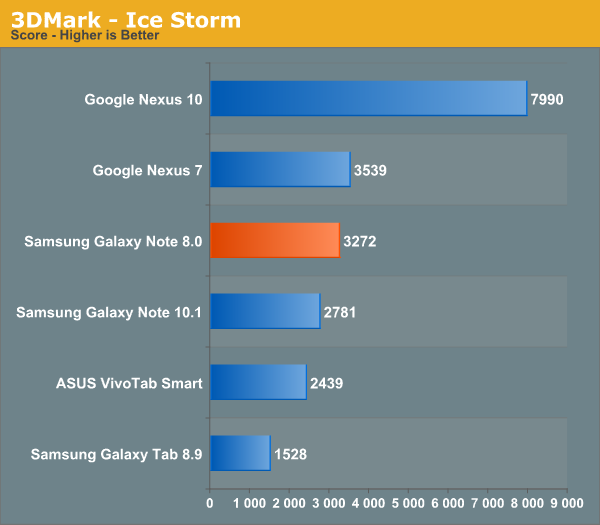
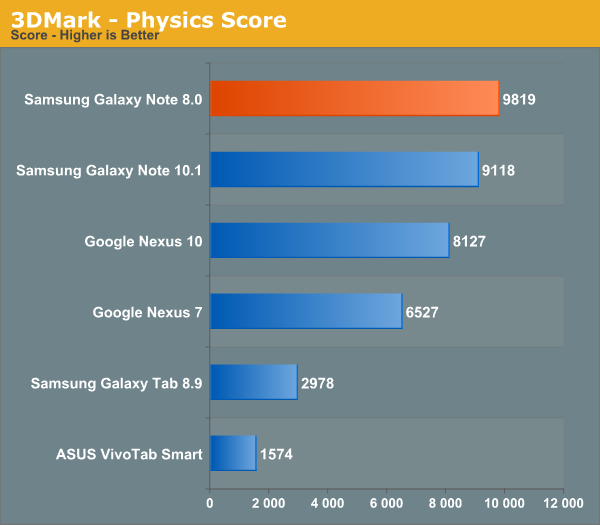
I tossed the physics test in here because it serves as an interesting multithreaded CPU benchmark. The results are largely unrealistic (a pair of Cortex A15s should almost always be quicker than four Cortex A9s at a lower frequency in most real world Android apps), but it does highlight the combination of core count and clock speed upgrades that we've seen over the past 2 years in the mobile tablet space.
Basemark X
Basemark X is a new addition to our mobile GPU benchmark suite. There are no low level tests here, just some game simulation tests run at both onscreen (device resolution) and offscreen (1080p, no vsync) settings. The scene complexity is far closer to GLBenchmark 2.7 than the new 3DMark Ice Storm benchmark, so frame rates are pretty low:
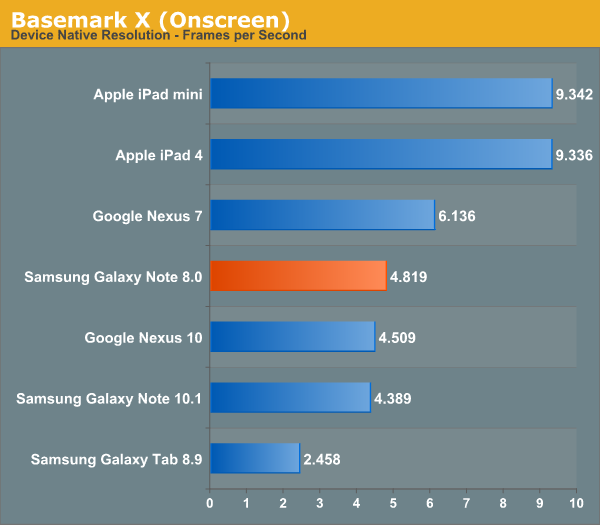
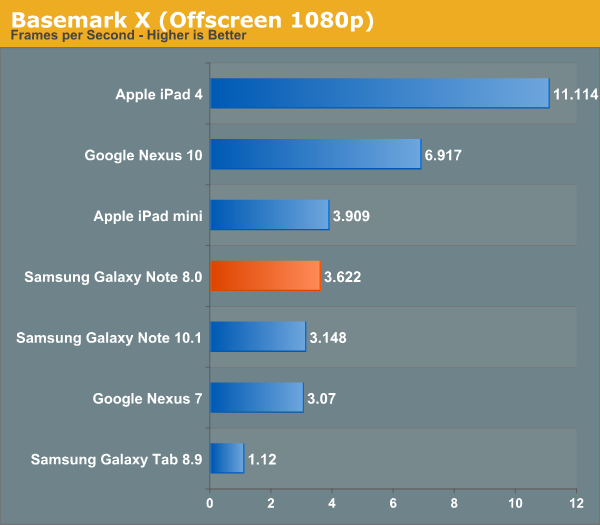
Basemark puts the Galaxy Note 8.0 behind the iPad mini in GPU performance and roughly 2 - 3x the performance of the Galaxy Tab 8.9.
GLBenchmark 2.7
GLBenchmark 2.7 gives us some low level results to look at. We'll start with peak theoretical fill rate and triangle throughput tests:

The Mali 400MP4 in the Galaxy Note 8.0 is capable of delivering similar fill rate to the PowerVR SGX 543MP2 in Apple's iPad mini, but the latter still holds an appreciable performance advantage. The gap between the 8.0 and 10.1 Galaxy Note models boils down to clock speeds. Compared to the old Galaxy Tab 8.9, the Note 8.0 puts its spiritual predecessor to shame.
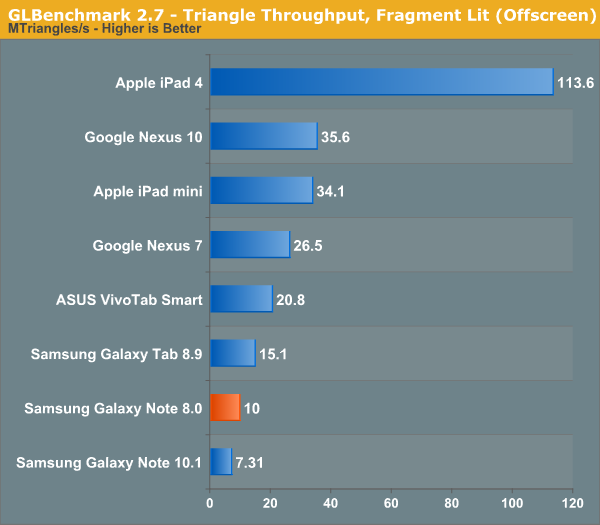
Can anyone say regression? ARM's Mali 400MP4 was never very strong from a triangle throughput standpoint, technically the Galaxy Tab 8.9 is quicker here (although you'll pretty much never see it surface in an actual game). The two GLBenchmark 2.7 test scenes follow:
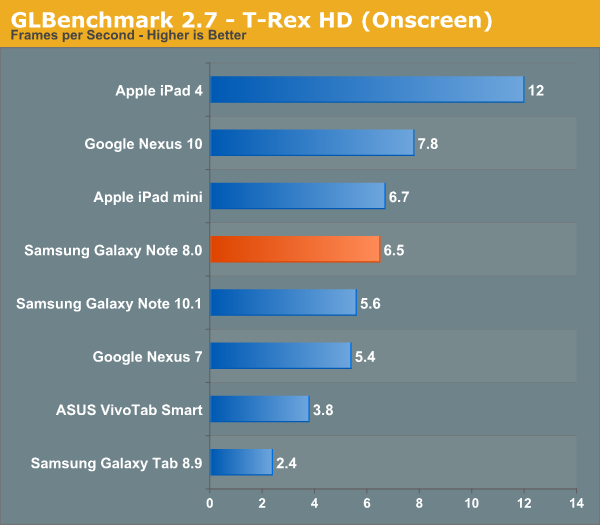

GLBench puts the Note 8's overall performance just slightly behind that of the iPad mini, and ahead of the mini if you compare identical workloads (offscreen 1080p). Obviously the GPU included here isn't anywhere near powerful enough to run the T-Rex HD workload at reasonable performance levels, but I wouldn't expect that to really hamper gaming performance for at least another two years.
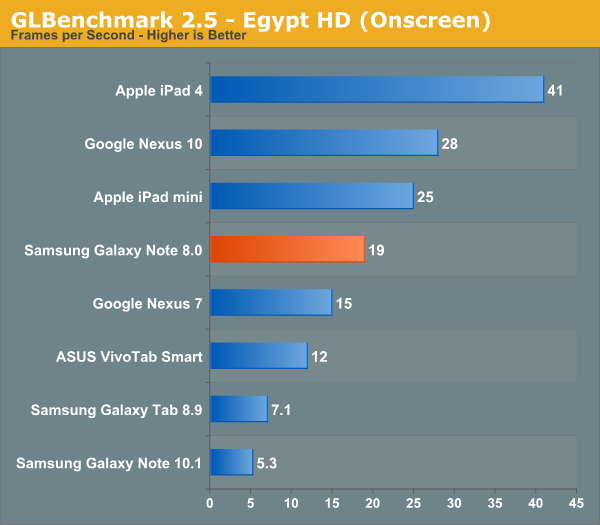
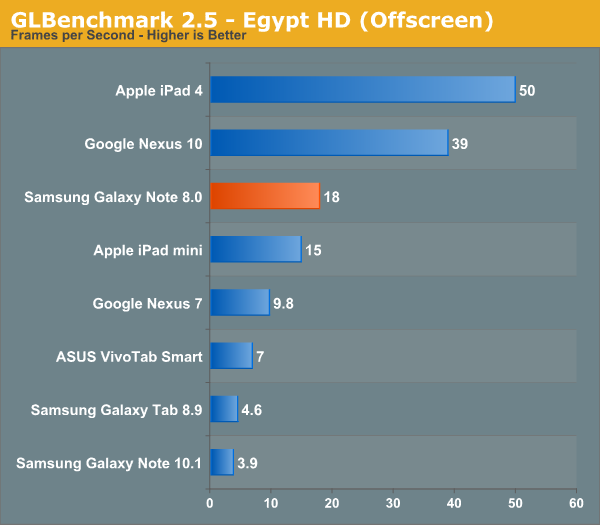
Egypt HD gives us a better look at what performance will look like in the near term. Once again, at native device resolution the iPad mini does better than the Note 8.0 but with the same workload/resolution their roles reverse. What we usually see, regardless of capabilities, is good real world performance by pretty much anything on the market. Most game developers seem to treat modern tablets like game consoles and attempt to deliver a good experience across the lowest common denominator rather than targeting the absolute high end.










95 Comments
View All Comments
herts_joatmon - Friday, April 19, 2013 - link
You could always root this, under clock and undervolt the CPU thus giving you Nexus 7 level performance and improved battery life. I also assume that the Wacom digitizer tech used in this uses additional electricity meaning that if it was applied to the Nexus 7, you would probably get reduced battery life anywayHisDivineOrder - Thursday, April 18, 2013 - link
The reason Samsung is doing a sea of niches is because they've got the advantage of a huge manufacturing infrastructure they can rely on to do it and do it well. They intend to drown Apple in an ocean of different products at different sizes and specs, bombarding the consumer in so much product there's little chance they haven't made something better for you in an Android variety.Poor Apple. They aren't destined to win this one. They're going to be shoved back into that niche box by the end and a big part of the reason will be Samsung, their ex-partner they burned with lawsuits and price bickering. Another large part of the reason will be the fact that Apple seems to be tapped out on new ideas or innovative styling.
Now everything's just, "Thinner, silverer, black/white-er." They're like fans of a dead man who can't appreciate anything new because of a blind devotion to the rapidly decaying chic of the dearly departed.
nerd1 - Friday, April 19, 2013 - link
Samsung has some advantage over other OEMs, but not over apple. BOM of apple products are always much cheaper, and they are enjoying double the margin of others.Mercadian - Thursday, April 18, 2013 - link
Hi Anand,Why have you stopped benchmarking mobile SoCs with Epic Citadel? I remember you did a great job with iPhone 4S review.
Jumangi - Thursday, April 18, 2013 - link
I don't know why Samsung thinks this thing is worth $400. I'm not the biggest Apple fan but at that price I would just buy the iPad.herts_joatmon - Friday, April 19, 2013 - link
Look up the price of a wacom tablet. then add that price to the iPad to get a comparable price. This is a modern tablet and graphics tablet in one The ipad is just a modern tablet.nerd1 - Friday, April 19, 2013 - link
iPad users are actually paying $100 to get JOT stylus to get a half-baked pressure sensitivity...SuperSuperChicken - Friday, April 19, 2013 - link
"If you’re the type of person to value, polish and take care of the things you own, the Note 8’s construction doesn’t convey luxury. If you want something you’re not going to feel bad about tossing about like you would your keys or a bag, maybe a plastic tablet is less of a problem."I see this a lot on Anandtech lately, with the phone reviews and now this. The insinuation is that if I don't want a metal-cased device, then automatically I'm one that doesn't care about the condition of my devices or how they look, which is simply not true.
Now, I'm no fan of glossy plastic, I would have hoped the manufacturers would have moved away from it by now. However, I am a fan of plastic and prefer it over metal devices such as the iPad due to the fact that in the real world, I can actually hold onto a plastic device whereas the metal ones tend to slip through my fingers. I think the Nexus 7 is a nice looking device, but even I'm not foolish enough to argue that it looks better than the iPad. However, when I have to encase the iPad in a cover in order to be able to hold it, it seems the point is moot.
I appreciate quality materials, however, in my case it doesn't take precedence over practicality. With plastic bodies, I can run my phone and tablet without cases, keeping them slim as designed - which is something metal bodied devices wouldn't be able to offer. I just ask that you keep that perspective in mind and don't just assume that everyone who has a plastic-bodied device doesn't care how it looks and is want to mistreat them.
nerd1 - Friday, April 19, 2013 - link
I see lots of plastic cases for metal phones - I wonder why nobody makes a metal case for plastic phones.SuperSuperChicken - Friday, April 19, 2013 - link
Companies do, actually (search for "metal case galaxy s3"). I'm not sure how much I'd trust them not to degrade reception though.